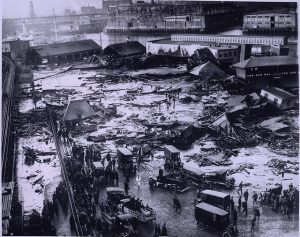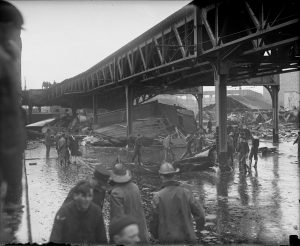Tuesday, January 15, 2019 is the 100th anniversary of Boston’s Great Molasses Flood. Shortly after noon, on that day in 1919, a storage tank containing over 2.3 million gallons of molasses collapsed in the city’s North End. A wave of molasses, estimated by some to be as high as 15 feet, and moving at a speed of approximately 35 miles per hour, swept through the area.
The flood was over in less than five minutes and rescuers, including over a hundred sailors from the USS Nantucket, quickly arrived on the scene. The next day, an article in the Boston Post provided a graphic account of the sight that met the first responders:
“Molasses, waist deep, covered the street and swirled and bubbled about the wreckage. Here and there struggled a form — whether it was animal or human being was impossible to tell. Only an upheaval, a thrashing about in the sticky mass, showed where any life was. Horses died like so many flies on sticky fly paper. The more they struggled, the deeper in the mess they were ensnared. Human beings — men and women — suffered likewise.”
The flood killed 21 people, injured about 150 more, and caused extensive damage to property. Cleanup took weeks. Crews washed away the molasses with salt water, and used sand to absorb it. But what had caused the disaster? Why had the molasses holding tank ruptured?
The holding tank belonged to The United States Industrial Alcohol Co. (USIA). The company used the tank to store the molasses it needed to make rum and industrial alcohol for munitions. In the aftermath of the tragedy, many lawsuits were filed against USIA. The company tried to explain away the disaster by blaming bomb-planting anarchists. The court-appointed auditor’s report found, however, that the tank collapsed because of structural weakness. USIA was held liable, and ordered to pay damages.
Two modern studies have revisited the collapse and its causes. One Harvard University study looked at the impact low winter temperatures had on the disaster. A 2015 study by a team of structural engineers analyzed how the construction of the tank, and the type of steel used, contributed to the collapse.
The tragedy led to stricter construction codes in Massachusetts, and other states across the country.
Tuesday, January 15, 2019 is the 100th anniversary of the flood, and the Central Library is hosting an author talk on that date. The talk is with local author Puleo, author of Dark Tide, the definitive account of the disaster, and a worthwhile read for those interested in learn more about it.
Dark Tide:The Great Boston Molasses Flood of 1919
For a child with an interest in history, The Great Molasses Flood by Kops is a great introduction.




Add a comment to: Boston’s Great Molasses Flood